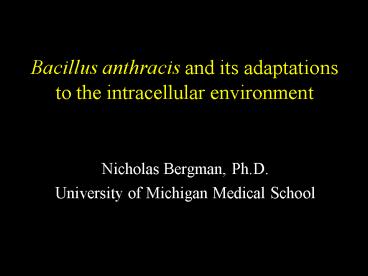Bacillus anthracis and its adaptations to the intracellular environment - PowerPoint PPT Presentation
1 / 12
Title:
Bacillus anthracis and its adaptations to the intracellular environment
Description:
Photo courtesy N. Fisher. N. Bergman & L. Shetron-Rama ... Amy Miyoshi. Matt Niemeyer. Brian Janes. Nick Bergman. Phil Hanna. Summary ... – PowerPoint PPT presentation
Number of Views:206
Avg rating:3.0/5.0
Title: Bacillus anthracis and its adaptations to the intracellular environment
1
Bacillus anthracis and its adaptationsto the
intracellular environment
- Nicholas Bergman, Ph.D.
- University of Michigan Medical School
2
B. anthracis pathogenesis
(Passalacqua and Bergman, 2006)
3
Analysis of B. anthracis gene expression within
host cells
N. Bergman L. Shetron-Rama
Major obstacleIsolating bacterial RNA from
within infected cells
- Mixed samples contain overwhelming amounts of
contaminating eukaryotic RNA - Initial attempts to analyze these samples on a B.
anthracis microarray yielded no usable data
(extremely high background)
4
Differential lysis as a tool for isolation of B.
anthracis RNA from mixed samples
Mixed sample containing B. anthracis and murine
RAW cells
Low-speed centrifugation
Pellet containing intact B. anthracis cells (time
elapsed 5 min)
- Control experiments
- B. anthracis viability is not affected by
incubation for 5 min in high concentrations of
saponin - B. anthracis gene expression does not change
appreciably after 5 minute incubation in saponin
5
B. anthracis gene expressionin vivo vs. in vitro
- Germination/early outgrowth inside a MF compared
to in MGM - 40 genes more highly expressed inside macrophages
(SAM parameters- FDR - Subset includes lef (6-fold), pagA (9-fold), and
pagR (12-fold) - Pathways/Functional Families Up-regulated within
Host Macrophages - Purine biosynthesis (p 3.4e-17, genes induced
by 6-15X) - Iron acquisition (p 1.2e-09, genes induced by
5-7X)
6
B. anthracis gene expressionin vivo vs. in vitro
- Vegetative growth inside a MF compared to in MGM
- 448 genes more highly expressed inside
macrophages (SAM parameters- FDR
change 2.00) - Subset includes lef (9-fold), pagA (6-fold), and
pagR (7-fold), atxA (4-fold), and cyaA (3-fold) - Pathways/Functional Families Up-regulated within
Host Macrophages - Purine biosynthesis (p 1.1e-12, genes induced
by 8-12X) - Iron acquisition (p 1.5e-15, genes induced by
9-24X) - Biotin biosynthesis (p 1.4e-07, genes induced
by 9-13X) - NAD biosynthesis (p 4.1e-03, genes induced by
18-36X) - This subset also includes 200 hypothetical genes
that are expressed at levels that are up to
90-fold higher during growth inside the macrophage
7
Identifying B. anthracis genes critical for
infection--basic biology
- Constructed a KO strain missing the GBAA1941 gene
(uncharacterized MarR transcriptional regulator)
using a markerless replacement system - No phenotype observed in vitro
- Growth in MGM, BHI indistinguishable from
wild-type - Sporulation appears normal, and spore yields are
within normal range
- In mouse model of inhalational anthrax
significant attenuation
p
DBA/2J mice, Intratracheal inoculation, 10x LD50
8
B. anthracis gene expressionin vivo vs. in vitro
- Vegetative growth inside a MF compared to in MGM
- 448 genes more highly expressed inside
macrophages (SAM parameters- FDR
change 2.00) - Subset includes lef (9-fold), pagA (6-fold), and
pagR (7-fold), atxA (4-fold), and cyaA (3-fold) - Pathways/Functional Families Up-regulated within
Host Macrophages - Purine biosynthesis (p 1.1e-12, genes induced
by 8-12X) - Iron acquisition (p 1.5e-15, genes induced by
9-24X) - Biotin biosynthesis (p 1.4e-07, genes induced
by 9-13X) - NAD biosynthesis (p 4.1e-03, genes induced by
18-36X) - This subset also includes 200 hypothetical genes
that are expressed at levels that are up to
90-fold higher during growth inside the macrophage
9
Identifying B. anthracis genes critical for
infection--new drug targets?
- NAD biosynthesis pathway in bacteria
- Aspartate --------- Nicotinate nucleotide
----------- NAD - (nadBAC)
(nadDE) - (induced 18-36X in vivo) (no change
in expression level) - nadDE have been shown to be essential in other
bacteria (e.g. Bacillus subtilis), but nadBAC are
not (NAD salvage pathway allows cell to recycle
Nicotinate nucleotide). - nadBAC genes can be deleted singly or together in
B. anthracis with no effect in non-minimal medium
- Does their expression profile suggest they might
be critical for infection?
10
Identifying B. anthracis genes critical for
infection--new drug targets?
- NAD biosynthesis pathway in bacteria
- Aspartate --------- Nicotinate nucleotide
----------- NAD - (nadBAC)
(nadDE) - (induced 18-36X in vivo) (no change
in expression level)
11
Acknowledgments
The Scripps Research Institute Emily Chen Helena
Prieto John Yates
University of Michigan Erica Anderson Ellen
Swenson Amy Miyoshi Matt Niemeyer Brian
Janes Nick Bergman Phil Hanna
12
Summary
- The intracellular environment presents some
unique challenges to a pathogen, and requires
significant adaptations in gene expression and
metabolism. - Identifying these adaptations provides clues
about the basic biology of infection, and points
us toward new potentially useful targets. - Many of these targets would have been missed by
other bioinformatic and experimental target
screens































